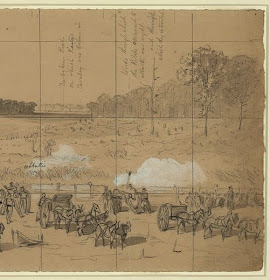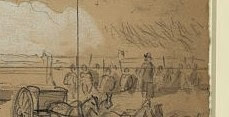 |
| Waud, W. "The battle of the Darbytown Road," (LOC) |
In recognition of the 150th anniversary of the October 7, 1864 fighting along the Darbytown and New Market Roads, here's a look at a sketch drawn by combat artist William Waud that day. The battle is covered in detail in
Richmond Must Fall: The Richmond-Petersburg Campaign, October 1864.
On October 7, 1864, Robert E. Lee launched an offensive in Henrico County to regain ground lost to Union forces a week before. In essence, Lee sought to recapture Fort Harrison, a key stronghold in the lines east of Richmond. The Confederate operation began encouragingly when Charles Field's infantry division, aided by South Carolina cavalry, routed August Kautz's Union horsemen positioned at Dr. Johnson's Farm near the Darbytown Road. After this modest victory, Lee's force pushed south and attacked Union infantry positions at the New Market Road. Once again, Field's men led the way. However, the effort ultimately failed.
Before Field's battle lines pressed the assault, a fierce artillery duel occurred between the rebel First Corps guns of Porter Alexander and Union Tenth Corps batteries hurriedly wheeled into new defenses edging the New Market Road. William Waud was there to witness these events and prepared this sketch looking north from behind the Union guns toward the approaching Confederates.
.jpg) |
| Detail (left half of drawing) |
.jpg) |
| Detail (right half of drawing) |
The map below shows Waud's approximate location, along with his view from behind the Tenth Corps line. The area depicted lies about six miles southeast of downtown Richmond. Fort Harrison, Lee's target for the operation, is about a mile southwest of the map's bottom left-hand corner. Waud's position was probably near the intersection of the modern day Gregg and Lammrich Roads, just north of the New Market Road. Lammrich Road roughly tracks part of the Union defense line on October 7, 1864. To the north, the Johnson House site (shown on the map below) sits today on Henrico County's Dorey Park. The Richmond airport is about a mile north of map's top edge.
 |
| Waud's perspective from behind the Union guns (LOC) |
The eyewitness sketches of Waud and his fellow combat artists provide rare windows into the Civil War battlefield. On close examination, this particular drawing furnishes some interesting details about the fighting on October 7, 1864.
#1 Alexander's Guns: On the left, in the distance across a
cornfield, smoke rises from the tubes of Porter Alexander's guns at the
Kell House. Alexander had driven his batteries south from Darbytown
Road using a maneuver known as "fire advancing by half battery." In
essence, half his guns fired while the other half leapfrogged
past. At the Kell property, Alexander halted, unlimbered all his
pieces, and began firing at the Union line. The day after the battle, a
Union cavalryman examined the spot and found that the rebels had dug small holes for cover.
.jpg) |
| #1 Alexander's guns at the Kell House |
#2. Tenth Corps Artillery: At the bottom center,
Waud drew four guns from the Union Tenth Corps artillery brigade
commanded by Richard H. Jackson. Jackson deployed several batteries for
the fight behind newly erected works just north along the
New Market Road. Waud did not identify the unit depicted in
the drawing. During the battle, Union artillerists used two unusual "Requa" guns, which had twenty-five .58 caliber barrels mounted in a
row at the top of a platform. However, these do not appear in the drawing. In addition, the Federals wheeled two
pieces from Battery D, 1st U.S. Artillery out into the cornfield in
front of the works seen here. Those guns received much attention
from Alexander's men.
.jpg) |
| #2. Tenth Corps artillery |
#3. Corn Stalks: Waud etched in some corn stalks only several feet behind the gun crews along the new line, revealing just how new these works were.
.jpg) |
| #3. Corn stalks just behind the Federal works |
#4. Union Infantry: On the lower right, infantry of the Tenth
Corps crouch behind the works, waiting for the Confederate attack. The federal fortifications stretched to the right of the sketch only for a short
distance. The position taken by the Tenth Corps troops extended
much farther. Thus, much of the Union battle line fought without cover in largely wooded terrain. The
men shown here are likely from Colonel Francis B. Pond's brigade,
which contained regiments from Illinois, Ohio, and Pennsylvania.
.jpg) |
| #4. Infantry from Pond's Brigade |
#5. Lee's Men Darbytown Road: In the distance, through a gap in the
trees, Waud has labeled the Darbytown Road, where Lee's forces overran Kautz's weak cavalry force at the Johnson Farm that morning. If you look closely at the base of the
tree line in the distance, it appears Waud has penciled in Lee's infantry gathering for their attack. Given the open ground and formidable Union artillery presence, the Confederate
infantry veered toward the woods to the right (of the drawing) and into a difficult
swamp, which caused much delay in the advance. Today, trees and houses
block this view but the sketch reveals how open this part of the Henrico
landscape was in 1864.
.jpg) |
| #5. The Darbytown Road and Lee's infantry |
#6. Recently Cleared Field: The sketch also shows the area in
front of the trenches recently cleared by Union troops.
Federal skirmishers used the stumps and felled trees for cover as
Field's men advanced. The Texas brigade, from Field's division, found
the slashing difficult
to navigate for it poked at their "eyes, faces, bodies, and clothing."
.jpg) |
| #6. Recently cleared field of fire |
#7. Confederate Attack: Following the artillery duel, Field's
attack emerged from the woods to the right and along a front that
extended far to the right of the sketch's frame. Thus, the
battle lines stood facing each other in woods covering much of the
area to the right.
.jpg) |
| #7. Woods from which Charles Field's Confederate division emerged |
Many of the Union regiments in this battle carried Spencer repeating
rifles. These weapons proved decisive, crushing the Confederate attack
and quickly ending the offensive. Waud also drew this sketch (below) of the
open fighting in those woods during the Confederate attack.
 |
| "The fighting was done in thick woods. Our men shewn[sic] in this sketch are armed with the Spencer Rifle." (W. Waud, LOC) |

.jpg)
.jpg)


.jpg)
.jpg)
.jpg)
.jpg)
.jpg)
.jpg)
.jpg)
